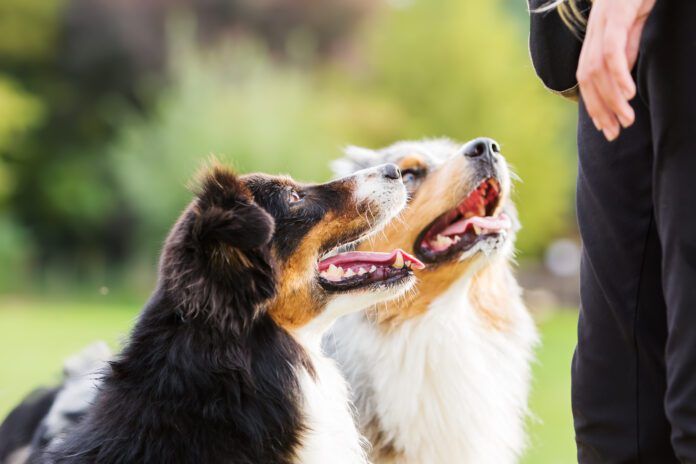Any dog lover will tell you that their dog can understand them to one degree or another. We communicate with our dogs via words, facial expressions, hand signals, and body language, and our dogs respond.
And science is catching up to what we experience every day! Studies prove that dogs can understand our words and facial expressions. Some of this understanding is learned over time through life experience or intentional training, but some of it is innate.
Exactly how much dogs understand what we say and do can be difficult to measure, but we are starting to see more complex studies that are looking at how dogs interpret more abstract concepts, and even how they can learn to use language to “talk” back to us.
Can Dogs Understand Humans?
Absolutely. Dogs definitely learn the meaning of individual words and phrases (such as objects, names of people or other pets, and verbal cues that indicate a behavior or action), and understand our tone, facial expressions, and body language such as pointing.
For example, pointing at a toy and saying, “Get it!” uses several different types of communication. Your dog has likely already been taught that “get it” means to grab a toy and bring it to you. The presence of a toy in the room backs up that understanding, and by pointing, you are indicating which toy you want retrieved.
Most of our communication with our dogs is made up of these mixed-media interactions. Over time, this can develop into a unique “language” shared only between you and your dog—your unique relationship with your dog, from your experiences together to your knowledge of her breed and upbringing, all come together to form the human-animal bond and your ability to communicate with each other.
While there is overlap between many dog-human pairs, there are also things that only make sense to specific duos. For example, many dogs have been taught the cue “sit.” If you walk up to a strange dog and say, “Sit,” the dog will probably respond in kind. But your dog may also know something that other dogs don’t. For example, my dog has learned that three taps means to move to a different spot on the bed. If I tapped a strange dog, odds are he would think I didn’t know how to pet properly.
And it isn’t just context that allows our dogs to understand what we are saying. One study looked an MRI imaging of dogs’ brains when they were shown an object and a person said either the name of the object or something else (for example, held up a ball but said, “bowl”). The same parts of the brain lit up in dogs when shown a mismatched pair as happens with humans! The dogs clearly recognized when a familiar object was paired with the wrong but still familiar word.
Talking Buttons for Dogs
The development of talking buttons has been a fun evolution in how dogs understand humans and communicate back. The idea originally came from a series of buttons used to help children learn language.
You can teach your dog a word or phrase, and then record it onto a button and teach the dog to press the button. For example, your dog might press, “Outside,” when she needs to go out to pee. Or she might press, “Hungry” to request a treat.
Talking buttons have become popular all over the world, and some dogs have made amazing connections when communicating with their people. As dogs learn more words, their people add additional buttons to their boards.
A study just published in August 2024 used button boards to show that dogs know the meaning of the words without any context clues being given. For example, many of us ask our dogs if they want to go for a walk as we stand up and head for the door. Our dogs could be responding to the word “walk,” but could also just be responding to our body language indicating that we are heading outside and want the dog to come with. This study broke that down.
For the study, each dog’s button boards were covered so the experimenter didn’t know which one they were pressing. The experimenter then pressed a button and stayed still, while a second experimenter recorded what the dog did in response. The dogs responded appropriately to both words that indicated playtime (by grabbing a toy) or going outside (headed toward the door).
Do as I Do
Another innovative means of communicating with your dog is the “Do as I Do” method. Trainers who use Do as I Do teach their dogs to mimic their movements. This is called social learning because the dog is learning to perform a behavior by watching their person do it first.
Researchers in Italy have done several studies with dogs trained to Do as I Do, including one that compared how quickly and well dogs learned a new task through either shaping (clicker training) or Do as I Do. The task for this study was opening the sliding door of a cabinet. Handlers using shaping would gradually shape the dog to touch and then move the cabinet door, while the handlers using Do as I Do would demonstrate opening the door and then ask the dogs to, “Do it!” The dogs who knew Do as I Do were able to master the behavior faster, and had good memory of how to do it 24 hours later, even in a new location.
Limitations of Speech When Communicating With Dogs
While dogs can understand humans to a point, there are limits. Once we get into full sentences and abstract concepts, things seem to break down for our canine companions.
Dogs have been shown to know the difference between a familiar spoken language and nonsense words, and the difference between different languages. A few dogs can learn basic syntax, or the arrangement of words to change meaning. For example, your dog may be able to understand instructions like, “Take the ball to Peter,” or “Bring the elephant to the chair.”
Another concept that dogs seem to struggle with is learning the name of something that they can’t see by observing a human talking about it. A small trial with four dogs placed different toys in buckets so that the dogs couldn’t see them, and then each dog’s owner looked in a bucket and said the name of the item several times. Then the buckets were dumped so the dogs could see all of the toys briefly. The toys were then placed in another room and the dogs were asked to fetch the named toy. It didn’t go particularly well, though one dog may have been figuring out the game.
So while your dog probably won’t be debating philosophy with you any time soon, some genius pups may understand a little more than the average dog.
How Many Words Do Dogs Understand?
We don’t have any controlled studies evaluating how many words dogs can learn, but we do have lots of anecdotal reports. You have probably heard of Rico the Border Collie who knew over 200 words, and Chaser the Border Collie who knew over 1000 words!
Researchers collected information on how many words people’s dogs knew via an online survey. This study found that on average, dogs know the meaning of 89 words. Owners who participated in the study felt that their dogs understood at least 15 words, with the most accomplished dog in the group knowing 215 words. Herding breed dogs (like those overachieving Border Collies) and toy-companion breeds generally had the most extensive vocabularies.
Body Language is Where It’s At
Dog language is mostly made up of body language. And they read our body language very well.
Dogs understand human facial expressions quite well, especially the basics of a friendly expression versus an angry or threatening one. The more time a dog spends interacting with humans, the better she gets at reading emotional expressions. Dogs are especially good at reading the faces of people they know well, but they can also read other people’s expressions. Even free-roaming stray dogs read human expressions and then use that information to make decisions.
As well as expressions, dogs also understand our posture and many of our gestures, like pointing.
Unfortunately, humans are not as good at reading dog body language. Countless videos online show dogs giving signals that they are uncomfortable, and the humans continuing what they were doing anyway. In many cases the person is hugging the dog or petting her too forcefully.
Some dogs do come to enjoy hugs from their owners and close human friends, but many dogs do not understand nor enjoy this type of contact. Consider how you would feel if a stranger just walked up to you and hugged you tight. You would probably feel confused, stressed, and trapped. The dog only gets more distressed when her signals of being nervous are ignored.
Dogs show many of the same signs of stress as we do—tense posture, dilated pupils, rapid breathing, and either extreme stillness or constant fidgeting. A happy, relaxed dog, on the other hand, will show loose body posture and a happy wagging tail.
Other Ways to Communicate With Your Dog
Use your imagination to come up with other ways to communicate with your dog—and vice versa!
Most of my dogs ask to come back inside from the yard by barking. But my youngest dog, Bruni, preferred to smash the door. To save both her growing elbows and my door, I taught her to press a doorbell at dog nose height to ask to come in. Now I can get things done in the house while she plays outside, and then when she’s ready to come in, she rings her doorbell.
As our dogs age, we may need to come up with ways other than spoken words to communicate. When I start to notice signs of hearing loss in my older dogs, I start teaching them to come to a blinking light. When the dogs are out in the yard at bedtime, I flick the lights three times, then call them in. This basic pairing teaches the dog that flicking lights equals “come.” By the time my senior dog’s hearing is gone completely, she already understands the light system to call her in.
And don’t overlook body language and signals. The “slow blink” is a well-know calming signal for dogs. If your dog seems a little stressed and you want to reassure her, make eye contact and then slowly blink. This signals to her that everything is okay and you are relaxed enough to take your eyes off the situation. When working with a stressed dog who doesn’t know you, you can make her feel more at ease by angling your body to the side and making sure your posture is loose. This helps her to feel less pressure and less threatened.
Bottom Line
Dogs really can understand humans quite a bit, from body language and facial expressions to words and phrases and our vocal tones. But while a few talented dogs may learn to understand some more complex syntax, most dogs tap out when you get to complete sentences and abstract concepts.






